
Thelymitra ixioides, known as the spotted sun orchid or dotted sun orchid, is a species of orchid that is native to southern and eastern Australia and to New Zealand. It has a single long, thin, dark green leaf and up to ten flowers which occur in a range of colours, most commonly blue to purple but usually with small, dark blue spots. It is a variable species, similar to T. juncifolia which has smaller flowers.
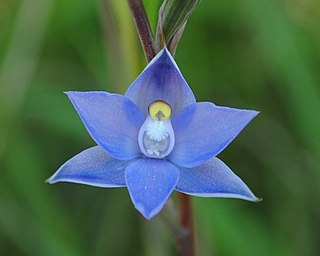
Thelymitra nuda, commonly known as the plain sun orchid is a species of orchid that is endemic to eastern Australia. It has a single fleshy, channelled leaf and up to twelve dark blue to purplish, sometimes white or pinkish flowers with white tufts on top of the anther. It grows in a range of habitats and sometimes forms large colonies.
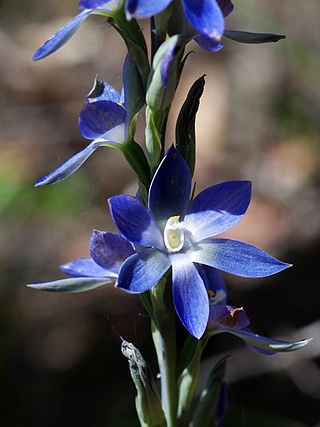
Thelymitra aristata, commonly called the great sun orchid, is a species of orchid that is endemic to south-eastern Australia. It has a single large, thick leaf and bracts and up to forty crowded blue or purplish flowers with darker veins.
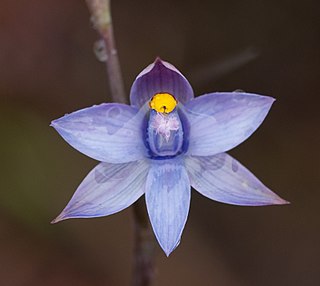
Thelymitra malvina, commonly called the mauve-tufted sun orchid, is a species of orchid that is native to eastern Australia and New Zealand. It has a single large, fleshy leaf and up to twenty five blue to mauve flowers with pink or mauve tufts on top of the anther.
Thelymitra angustifolia, commonly known as the long-leaved sun orchid is a species of orchid that is endemic to eastern Australia. It has a single erect, thin, channelled leaf and up to ten purplish blue flowers with white tufts on top of the anther. The flowers are self-pollinating.

Thelymitra basaltica, commonly called the grassland sun orchid, is a species of orchid that is endemic to Victoria. It has a single fleshy, channelled, dark green leaf and up to eight small pale blue, self-pollinating flowers which open only slowly on warm to hot days.
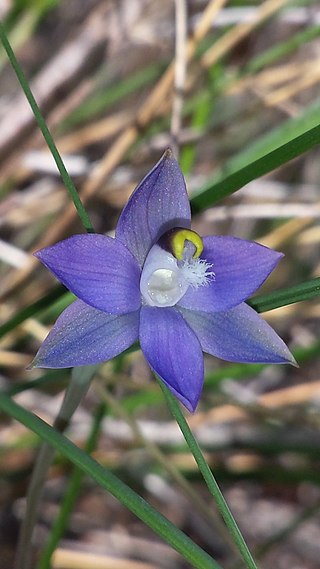
Thelymitra brevifolia, commonly called the peppertop sun orchid or short-leaf sun orchid, is a species of orchid that is endemic to south-eastern Australia. It has a single erect, relatively short and broad, dark green leaf and up to twenty purplish or purplish blue flowers. It is a common and widespread self-pollinating species occurring in a wide range of habitats.
Thelymitra exigua, commonly called the short sun orchid, is a species of orchid that is endemic to south-eastern Australia. It has a single fleshy, channelled, dark green leaf and up to eight relatively small pale blue flowers with white toothbrush-like tufts on top of the anther.

Thelymitra holmesii, commonly called the blue star sun orchid, is a species of orchid that is endemic to south-eastern Australia. It has a single long, narrow, fleshy leaf and up to nine purplish blue to mauve flowers with a deeply notched lobe on top of the anther.
Thelymitra pallidiflora, commonly called the pale sun orchid, is a species of orchid that is endemic to Victoria. It has a single erect, channelled, leaf and up to ten white to very pale blue, self-pollinating flowers which only open on hot days.

Thelymitra peniculata, commonly called the trim sun orchid, is a species of orchid that is endemic to southern eastern Australia. It has a single long, erect, fleshy, channelled leaf and up to eighteen deep blue to purple self-pollinating flowers.
Thelymitra planicola, commonly called the glaucous sun orchid, is a species of orchid that is endemic to southern eastern Australia. It has a single erect, leathery, channelled, dark green leaf and up to twelve blue flowers with darker veins. The plant has a bluish green hue and the flowers are self-pollinating, only opening widely on hot days.
Thelymitra reflexa, commonly called the reflexed sun orchid, is a species of orchid that is endemic to Victoria. It has a single erect, fleshy, channelled leaf and up to six bluish purple flowers. The sepals and petals are strongly turned back towards the ovary but only on hot days when the flowers open.
Thelymitra viridis, commonly called the green sun orchid, is a species of orchid that is endemic to Tasmania. It has a single erect, fleshy, channelled leaf and up to seven small self-pollinating pale blue to pale purplish flowers. The rest of the plant is a pale green colour.
Thelymitra inflata, commonly called the inflated sun orchid, is a species of orchid that is endemic to south eastern Australia. It has a single long, erect, linear leaf and up to six dark blue to purplish flowers with a very inflated lobe on top of the anther.
Thelymitra lucida, commonly called the glistening sun orchid, is a species of orchid that is endemic to south eastern Australia. It has a single erect, fleshy leaf and up to seven dark blue flowers with the sepals a lighter blue than the petals.

Thelymitra mucida, commonly called the plum sun orchid or plum orchid, is a species of orchid that is endemic to southern Australia. It has a single erect, fleshy, linear leaf and up to six blue, purplish or plum coloured flowers with a thick, sticky secretion on the anther lobe.
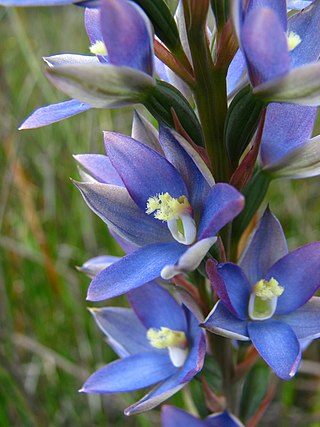
Thelymitra circumsepta, commonly called the naked sun orchid, is a species of orchid that is endemic to south-eastern Australia. It has a single leathery, dark green leaf and up to twenty blue to purplish or pink flowers with fringed lobes and yellowish hair tufts on top of the column.
Thelymitra incurva, commonly called the coastal striped sun orchid, is a species of orchid that is endemic to south-eastern Australia. It has a single erect, dark green grass-like leaf and up to seven relatively large, pale blue flowers lacking the darker veins of some other thelymitras, especially the otherwise similar striped sun orchid. It grows in coastal areas of far south-eastern New South Wales and north-eastern Victoria.
Thelymitra atronitida, commonly called the black-hooded orchid, is a species of orchid that is endemic to south-eastern Australia. It has a single erect, leathery, leaf and up to eight moderately dark blue, self-pollinating flowers that only open on hot days.










